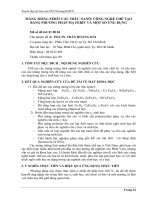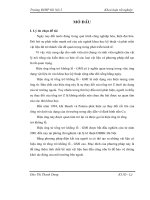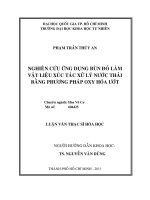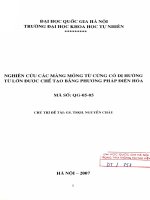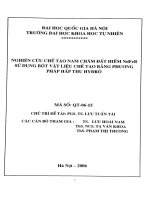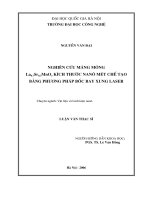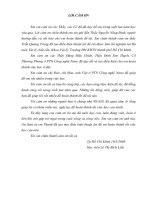Nghiên cứu vật liệu nano siêu mỏng mos2 pha tạp nitơ và vật liệu tổng hợp graphene mos2 chế tạo bằng phương pháp điện hóa plasma ứng dụng cho phản ứng sản sinh hydrô
Bạn đang xem bản rút gọn của tài liệu. Xem và tải ngay bản đầy đủ của tài liệu tại đây (5.91 MB, 152 trang )
國國國國國國
國國國國國國國國國
國國國國
國國國國國國國國國國國國國國國國國國國國國國-國國 國國國國國國國國國國國國
Nitrogen Doped MoS2 Nanosheets and Graphene/MoS2
Composite Prepared by Electrolysis Plasma-Induced Process
for Hydrogen Evolution Reaction
國國國: 國國國 國國國國國國國國 國
國
國國國國國國國國國國
國國國國國國國國國國國國國國國國國國國國國國-國國國國國國 國國國國國國國國
Nitrogen Doped MoS2 Nanosheets and Graphene/MoS2 Composite
Prepared by Electrolysis Plasma-Induced Process for Hydrogen
Evolution Reaction
國國國國國國國
Student: Nguyen Van Truong
國國國國國國國國 國國
Advisor: Dr. Kung-Hwa Wei
國國國國國國
國國國國國國國國國 國國國國
A Dissertation
Submitted to Department of Materials Science and Engineering
College of Engineering
National Chiao Tung University
in partial Fulfillment of the Requirements
for the Degree of
Doctor of Philosophy
in
Materials Science and Engineering
March 2020
Hsinchu, Taiwan, Republic of China
國國國國國國國國國國
國國
國國國國國國國國國國國國國國國國國國國國國國國國國國國HER國國國國國國國國國 國國國國國國國國國國國國國國國國國國國國國國國
國國國國國國國國國國國國國國 國國國國國/ 國國國國國國國國國國國國國國國國國國國國國國國國國國國國國國國國 國國國國國國國
80°C國國國國國國國國國國國國國國國國國國國國國國國國國國國國 國國國國國國國國國國國國國國國國國國國國國國國國國國國國國國國
國 2H-國國國國 國國國國國國國國國國國國國國國國國國國國國國國國國國國國國國國國國國國國國 國國國國國國國國國國國國國國國國國
–2
國國國國國國國國國國國國國國國 5.2 at國國國 國國國國國國國國國國國國國國 10 mA cm 國國國國國國國國國國國國 164
-1
-1
mV國Tafel 國國國國國國 71 mV dec –國國國國國國國國國國國國國國207 mV國82 mV dec 國國國 國國國國
-1
國國602 mV國198 mV dec 國國國國國 0.5 M 國國國國國 25 國國國國國國國國 國國國國國國國國國國國國國國國國
國國國國國國國國國國國國國國國國國國國國國 國國國國國國國國國國國國國國國國國國國OGNs @ 國國國國國國國國國國國國國國國
國國國國國國國國GNs @ 國國國國國國國國國國國國國國國國國國國國國國 HER 國國 國國國國國國國國國國國國國國國國國國國-國
國國國國國國國國國國國國國國國國國 國國國國國國國國國國國國國國國國國國 HER 國國國國國國國國國國國國國國國 OGNs
-2
@ 國國國國國國國國國國國國國國 HER 國國國國 10 mA cm 國國國國國國國國 118 mV 國國國國國國Tafel 國國
國 dec-1 國 Tafel 國國國國國國國國國國國國國國國國國國國國 國國國國國國國國國國國國國國國國國 GNs @ 國國國國
-1
國182 mV國82 mV dec 國國國國 國國國國國國國國國國國國國國國國國國國國國國國國國國國國國國國國國國國
國TMDCs國國國國國國國國國國國國國 TMDCs 國國國國國國國國國國國國國國國國國 國國國國
i
Nitrogen Doped MoS2 Nanosheets and Graphene/MoS2 Composite Prepared by
Electrolysis Plasma-Induced Process for Hydrogen Evolution Reaction
Student: Nguyen Van Truong
Advisor: Prof. Kung-Hwa Wei
Department of Materials Science and Engineering
National Chiao Tung University
Abstract
With the goal of obtaining sustainable earth-abundant electrocatalyst materials displaying high
performance in the hydrogen evolution reaction (HER), here we propose a facile one-pot
plasma-induced electrochemical process for the fabrication of both nitrogen-doped MoS2
nanosheets and graphene/MoS2 composite. An efficient one-step approach that involves
simultaneous plasma-induced doping and exfoliating of MoS2 nanosheets within a short time
and at a low temperature (ca. 80 °C) has been developed. Particularly, an active plasma zone
can be generated at the submerged cathode tip to achieve doping of nitrogen atoms into the
semiconducting 2H-MoS2 structure. The electronic and transport properties were modulated
under the synergy of the nitrogen doping and exfoliation in the MoS2 structure to enhance
their catalytic activation. It is found that the N concentration of 5.2 at % at N-doped MoS2
nanosheets have excellent catalytic hydrogen evolution reaction where a low over-potential of
164 mV at a current density of 10 mA cm–2 and a small Tafel slope of 71 mV dec–1—much
–1
lower than those of exfoliated MoS2 nanosheets (207 mV, 82 mV dec ) and bulk MoS2 (602
mV, 198 mV dec–1)—as well as an extraordinary long-term stability of >25 h in 0.5 M H2SO4
can be achieved. Interestingly, through a simple selection of cathode materials in one-batch
process, two different morphologies of graphene sheets were obtained, resulting in both
onion-like covered MoS2 nanosheets (OGNs@MoS2) and sheets-like graphene wrapped MoS2
composites (GNs@MoS2). We found that the presence of the graphene sheets appeared to be
ii
a key aspect of the enhanced HER ability. Therefore, we conclude that electronic coupling at
the graphene–
ii
MoS2 nanosheet interfaces also played an important role in enhancing the HER activity. Our
OGNs@MoS2
composites exhibited high HER performance, characterized by a low
overpotential of 118 mV at a current density of 10 mA cm–2, a Tafel slope of 73 mV dec–1, and
long-time stability without degradation; this performance is much better than that of the sheetlike graphene-wrapped MoS2 composite GNs@MoS2 (182 mV, 82 mV dec–1). This approach
appears to be an effective and simple strategy for tuning not only nitrogen-doped transition
metal dichalcogenide (TMDCs) materials but also the morphologies of composites of
graphene and TMDCs materials for a broad range of energy applications.
KEYWORDS: MoS2, Nitrogen doped MoS2, Onion-like graphene, Graphene/MoS2
composite, One-pot Plasma-Induced exfoliation, Hydrogen evolution reaction, electrocatalyst.
3
ACKNOWLEDGMENTS
This dissertation presents a summary of my research work which has done in the Department
of Materials Science and Engineering (MSE), National Chiao Tung University (NCTU). It is a
pleasure to express my sincere gratitude to all the people who helped and supported me during
my Ph.D. study.
From bottom of my heart I express my deep sense of gratitude and profound respect to my
supervisor Prof. Kung-Hwa Wei. He continually and convincingly conveyed a spirit of
adventure in regard to research and scholarship, and an excitement in regard to teaching.
Without his generous encouragement and brief advice for those years, this dissertation would
not have been completed. My sincere thanks Prof. Yu-Lun Chueh for his kind guidance and
persistent help.
I would like to thank Dr. Yen Po-Jen, Dr. Cheng Hao-Wen, Dr. Chen Hsiu-Cheng, Dr. VanQui Le, Mr. Phuoc Anh Le, Mr. Chung-Hao Chen, Mr. Tzu-Yi Yang, Mr. Yung-Chi Hsu, Mr.
Bo-Hsien Lin for their kind supporting in my research. Many thanks to all participants in Prof.
Kung-Hwa Wei’s lab who took part in the study and enabled this dissertation to be possible. In
addition, I would like to thank all members of Vietnamese Student Association-NCTU who
made my life in Taiwan really pleasurable and joyful.
Finally, special thanks for my parent, my wife and my two angels who always standing by my
side. Thank you for always encouraging me to pursue my dreams. I love you all so much,
thanks for loving me too!
Nguyen Van Truong
Hsinchu, Taiwan
April 2020
4
Table of Content
國 國 .............................................................................................................................................i
Abstract .....................................................................................................................................ii
Acknowledgment .....................................................................................................................iv
Table of Content ....................................................................................................................... v
Figures list ...............................................................................................................................vii
Tables list..................................................................................................................................xi
Chapter 1. Introduction ........................................................................................................... 1
1.1. Introduction of Transition metal dichalcogenides ......................................................1
1.2. Production of Transition Metal Dichalcogenides materials. ......................................3
1.3. Introduction of cathodic plasma exfoliation method ..................................................6
1.4. Introduction of Electrocatalytic Hydrogen Evolution Reaction .................................9
1.5. Introduction of nitrogen doped MoS2 .......................................................................12
1.6. Introduction of graphene/MoS2 composite...............................................................14
1.7. Strategies to enhancing MoS2 catalytic activity .......................................................16
1.8. Thesis outline............................................................................................................20
Chapter 2. Production Nitrogen-Doped Molybdenum Disulfide nanosheets through
Plasma-Induced process and their electrocatalyst performance .......................................
21
2.1. Introduction ..............................................................................................................21
2.2. Experimental section ................................................................................................24
2.3. Results and discussion ..............................................................................................27
2.4. Conclusions ..............................................................................................................50
5
Chapter 3. Production Graphene/MoS2 composite through One-Pot Plasma-Induced
process and their Electrocatalyst performance ................................................................... 51
3.1. Introduction ..............................................................................................................51
3.2. Experimental section ................................................................................................54
3.3. Results and discussion ..............................................................................................58
3.4. Conclusions ..............................................................................................................83
Chapter 4. Conclusions .......................................................................................................... 84
References ............................................................................................................................... 87
Vita........................................................................................................................................... 99
Publications list..................................................................................................................... 101
6
Figures list
Figure 1.1 The periodic table with highlighted transition metal and chalcogenide elements that
form layered TMDCs materials. .................................................................................................1
Figure 1.2 The crystal struture of TMDCs with Octahedral (1T), Trigonal prismatic (2H) and
(3R) coordination........................................................................................................................2
Figure 1.3 Six main production methods of TMDCs and their content ....................................3
Figure 1.4 Several TMDCs nanosheets production methods ....................................................5
Figure 1.5 Typical of plasma electrolysis and its applications..................................................6
Figure 1.6 Experimental setup and mechanism of cathodic plasma exfoliation ....................... 7
Figure 1.7 Schematic representation of the proposed mechanism of plasma exfoliation and
nitrogen-doping ..........................................................................................................................8
Figure 1.8 I-V curve of overall water splitting ........................................................................10
Figure 1.9 Schematic of the covalent nitrogen doping in MoS2 upon N2 plasma surface
treatment. .................................................................................................................................. 13
Figure 1.10 (a) Schematic illustration of the electrochemical deposition set-up; (b)
Comparison of MoS2-3D graphene hybrid in solution and solid state supercapacitor
.................................15
Figure 1.11 Synthesis procedure and structural model for mesoporous MoS2 with a doublegyroid morphology ...................................................................................................................17
Figure 1.12 the schematic preparation process of MoS2/N-RGO nanocomposite ..................19
Figure 2.1 (a) Experimental setup for plasma-induced exfoliation and (b) proposed
mechanism of exfoliation and nitrogen-doping process.
.............................................................................27
Figure 2.2 FE-SEM images of bulk commercial samples of (a) MoS2, (b) MoSe2, (c) WS2 and
(d) WSe2, respectively. .............................................................................................................29
vii
Figure 2.3 SEM images of exfoliated (a) MoS2, (b) MoSe2, (c) WS2 and (d) WSe2 nanosheets.
AFM images of exfoliated (e) MoS2, (f) MoSe2 and (h) WSe2 nanosheets. Raman spectra of
exfoliated (i) MoS2, (j) MoSe2, (k) WS2 and (l) WSe2 nanosheets. .........................................31
Figure 2.4 UV–Vis spectra of (a) MoS2, (b) MoSe2, (c) WS2 and (d) WSe2 nanosheets
........32
Figure 2.5 Low-magnification TEM images of (a) MoS2, (b) MoSe2, (c) WSe2 and (d) WS2
nanosheets. Insets show the corresponding SAED patterns. HRTEM images recorded along
the [001] zone axis. Insets: their filtered of (e) MoS2 (f) MoSe2, (g) WSe2, and (h) WS2.
STEM bright-field images of (i) MoS2, (j) MoSe2, (k)WS2 and (l) WSe2 nanosheets, and their
element
mapping
images,
respectively................................................................................................... 33
Figure 2.6 (a) Difference in frequency between E12g and A1g in Raman spectra and (b) the
lateral size of exfoliated MoS2 using different applied biases..................................................35
Figure 2.7 (a) Mechanism of the N-doped MoS2 nanosheets. (b-f) Dark-field STEM images of
undoped MoS2 and N-doped MoS2 nanosheets and the corresponding EELS elemental
mapping images of Mo, S and N with different electrolytes and/or plasma-induced time,
respectively 36
Figure 2.8 The statistical distribution of the lateral size of (a) undoped MoS2, (b) N-doped
MoS2 and (c) the thickness of MoS2 nanosheets ...................................................................... 38
Figure 2.0.21. XPS spectra (a) survey, (b) S 2p and (c) Mo 3d of Undoped MoS2 and N-doped
MoS2 nanosheets, respectively. ................................................................................................ 39
Figure 2.9 SEM images of N-doped MoS2 after the plasma-induced exfoliation at (a) 200 oC,
(b) 300 oC (c) 500 oC and their BF-STEM images(d-f), respectively, correspond with EDS
mapping of Mo, S and N elements. ..........................................................................................41
Figure 2.10 Raman spectra of N-doped MoS2 nanosheets after the thermal annealing at (a)
200,
(b)300,
and
(c)500
......................................................................................... 42
8
o
C,
respectively.
Figure 2.11 (a) LSV curves (recorded on a glassy-carbon electrode) of bulk MoS2, undoped
MoS2 and N-doped MoS2 (b) Corresponding Tafel plots derived from (a). (c) Nyquist plots
acquired at –200 mV vs. RHE of the bulk MoS2, undoped MoS2 and N-doped MoS2. (d)
Durability test of the N-doped MoS2 catalyst, performed at an overpotential of 165mV vs.
RHE
..................................................................................................................................................45
9
Figure 3.1 (a) Procedure and setup for the preparation of MoS2 nanosheets covered by onionlike graphene sheets (OGNs@MoS2) and MoS2 nanosheets decorated on sheet-like graphene
(GNs@MoS2); (b) Schematic representation of the proposed mechanism of OGNs@MoS2 and
GNs@MoS2 .............................................................................................................................. 58
Figure 3.2 Digital images of plasma-induced experiments of fabricating MoS2 nanosheets
wrapped with graphene nanosheets: (a) step 1: making MoS2 nanosheets, (b) step 2: making
graphene nanosheets on MoS2 nanosheets ...............................................................................59
Figure 3.3 a–c) SEM and (d–f) TEM images of (a, d) MoS2 nanosheets, (b, e) OGNs@MoS2,
and (c, f) GNs@MoS2 sample prepared through plasma-induced exfoliation. ........................60
Figure 3.4 (a) SEM and (b) low magnification TEM image of OGNs....................................60
Figure 3.5 EDS spectra of MoS2, GNs@MoS2 and
Figure 3.6 High resolution TEM image and insets SEAD of (a) MoS2 nanosheets and (b)
OGNs
..................................................................................................................................................63
Figure 3.7 AFM images of MoS2 nanosheets and corresponding height profile.....................63
Figure 3.8 (a) HR-TEM image and SAED pattern (inset) of the OGNs@MoS2 sample; (b)
expanded view; and (c) HR-TEM image of the same sample recorded from another position.
(d) STEM bright-field image of the OGNs@MoS2 sample and corresponding elemental
mapping of C, Mo, and S atoms. ..............................................................................................65
Figure 3.9 (a) HR-TEM image of the GNs@MoS2 sample and expanded views of its (b)
MoS2 and (c) GNs region; insets: corresponding SAED patterns. (d) STEM dark-field image
of the GNs@MoS2 structure and corresponding elemental mapping of C, Mo, and S
atoms............67
Figure 3.10 (a, b) Raman spectra and (c) XRD patterns of the OGN, MoS2, and OGNs@MoS2
samples. ....................................................................................................................................68
Figure 3.11 (a) XPS survey spectra of the OGN and OGNs@MoS2 samples. (b–d) Highresolution XPS spectra of the (b) C 1s, (c) Mo 3d, and (d) S 2p core levels............................70
9
Figure 3.12 High resolution XPS spectra of O1s of (a) OGNs@MoS2 and (b) MoS2
nanosheets.
..................................................................................................................................................71
10
Figure 3.13 (a) LSV curves of the OGNs, MoS2, GNs@MoS2, and OGNs@MoS2 samples and
the Pt electrode. (b) Tafel plots obtained from LSV curves. ....................................................72
Figure 3.14 Relationship between total amount of the MoS2 1T phase and Overpotential at
current density of 10 mA cm-2 of MoS2, GNs@MoS2 and
Figure 3.15 (a,b) SEM, (c,d) TEM and (e,f) images of MoS2 nanosheets prepared in 2M
H2SO4
and 2M NaOH ..........................................................................................................................78
Figure 3.16 LSV curves of MoS2 nanosheets prepared in acid (black) and base (red)
electrolytes
..................................................................................................................................................79
Figure 3.17 (a-c) SEM images and (d-f) corresponding of EDS spectra of OGNs@MoS2
prepared at different plasma electrolysis time conditions. .......................................................80
Figure 3.18 (a) Nyquist plots of the MoS2, GNs@MoS2, and OGNs@MoS2 samples; inset:
expanded view of the boxed area. (b) I–t test of the OGNs@MoS2 sample, recorded over 105 s
at an overpotential of 120 mV .................................................................................................. 82
11
Tables list
Table 2.1. Elements concentrations after the plasma-induced exfoliation at various
temperatures..............................................................................................................................42
Table 2.2. Materials, methods, N concentrations and phase of MoS2 at various N-doped MoS2.
..................................................................................................................................................44
Table 2.3. HER measurements of N-MoS2 nanosheets compared other results from literature
with H2SO4 0.5 M electrolyte. ..................................................................................................48
Table 3.1 Component ratio of MoS2, GNs@MoS2 and OGNs@MoS2 ...................................62
Table 3.2 Synthetic methods and HER performances of recently reported MoS2-based
materials
..................................................................................................................................................77
Table 3.3 Component ratio of OGNs@MoS2 prepared at different electrolysis plasma time
conditions..................................................................................................................................80
Table 3.4 HER performance of OGNs@MoS2 samples prepared at various of plasma time and
pulse supply power conditions .................................................................................................81
12
Chapter 1. Introduction
1.1. Introduction of Transition metal dichalcogenides
Owing to numerous of fascinating properties, the most famous of two-dimentional
materials (2D), graphene has been very populated for a worldwide range of possible
applications. Other members in family of layered inorganic material, transition metal
dichalcogenides (TMDCs) which are semiconducting materials with a typical MX2, where M
is a transition metal such as Mo, W and X is a chalcogenide, such as S, Se exhibited many
intriguing scientifically and technologically properties. Discovered their structure in 1923 by
Linus Pauling1, figure 1.1 shows more than 40 type of TMDCs which were known as layer
structure by late 1960s. To 1986, the first research on monolayer MoS2 was reported2. In
parallel with the exploding of research on graphene when discovered by A. Geim and K.
Novoselov in
20043, which was opened the new studying way for TMDCs. As a typical of layered material,
TMDCs is the lamellar hexagonal structure with each layer were formed by X-M-X layer
without dangling bonds between layers which related to other by the weak van der Waals
forces.
1
Figure 1.1 The periodic table with highlighted transition metal and chalcogenide elements
that form layered TMDCs materials.4
2
Figure 1.2 The crystal struture of TMDCs with Octahedral (1T), Trigonal prismatic (2H) and
(3R) coordination
Figure 1.2 shows the three possible phase of MX2 materials by the crystallography5,
which include 1T-, 2H and 3R- phase. In the 2H- and 3R- phase, the Mo atoms locate at the
center of triangular prisms while the Mo atoms are at center of the octadedral in the 1T- phase
case. Furthermore, the staking method of “A-b-A” is the feature of 2H- and 3R- phase and
“A-b-C” for 1T- phase. In addition, the 3R- phase is less stable than that of the 2H phase,
therefore, 3R- phase can easily convert to 2H- phase. The 1T- phase is the octahedral metallic
phase which can be converted from semiconducting 2H phase by several methods such as
liquid exfoliation6,7 or microwave assisted8,9. Specially, the appearance of 1T- phase can be
enhanced the electrocatalytic activity of TMDCs.
Due to the unconventional electronic properties of TMDCs, the stable 2H phase is the
semiconductor phase. At room temperature, the carrier motilities and Young’s modulus of
monolayer MoS2 are 100 cm2 V-1 S-1 and 0.27 TPa, respectively, which are much lower than
those of graphene (2.5x105 cm-2 V-1 S-1 and 1 TPa). From the point view of band structure,
3
simultaneously with the thickness decreasing, the indirect bandgap semiconductor in bulk
counterpart change to direct bandgap in monolayer. For example, the experiment value for
bandgap of bulk and monolayer semiconducting 2H-MoS2 are around 1.3 eV and 2.1 eV,
respectively. This changing from indirect to direct bandgap of bulk to monolayer material
appears from quantum confinement effects. These properties of TMDCs can open up
promising for valleytronics and/or electrochemical energy storage applications.
1.2. Production of Transition Metal Dichalcogenides materials.
Figure 1.3 Six main production methods of TMDCs and their content10
TMDCs have many of morphology with numerous of shapes, sizes or phases, such as
nanosheets, nanoparticle, nanostructure, nanofibers. Among them, the ultrathin TMDCs
materials have been exhibited the different chemical, physical and electronic properties with
their bulk counterpart which give great promising for a board of applications. Up to date, there
are two main approaches to prepare mono or few layers TMDCs nanosheets are top-down and
bottom up routes. Basically, top-down methods isolated TMDCs nanosheets from bulk
materials such as mechanical, liquid exfoliation, or electrochemical exfoliation. Bottom up
methods include chemical vapour deposition (CVD), physical vapour deposition (PVD) and/or
wet solution, where the layered 2D materials are mostly formed by self-assembly which can
4
deposit large-area of monolayer or few layers TMDCs with high-quality and uniform
thickness. However, cost effect, scalable, high modern technique, high temperature and
vacuum requirements are their disadvantages. The mechanical cleavage method which use the
adhesive tape to produce high-quality TMDCs nanosheets however the long-time process and
slow rate are unchanged. This method can only suitable for fabrication of individual devices
or fundamental characterization. Recently, the laser spot is more attractive in producing
monolayer TMDCs, although the scalable and laser rating is the barrier for scale-up
producing. The most commonly and promising method is liquid phase exfoliation. With high
quantity of sub-micrometer to sub-nanometer size of TMDCs nanosheets production, the
liquid phase exfoliation method can be allowed for industrially scalable. Particularly, the
exfoliated TMDCs nanosheets electronics structures are changed from semiconducting (2H)
phase to metallic phase (1T) phase. The intercalation and exfoliation in the liquid phase
method produce TMDCs nanosheets into different sizes with structure distortions although
they show high rate production. The lithium ions intercalation was discovered from 1975 by
Martin B. Dines11. Bulk TMDCs was immersed into n-butyl lithium one day for the
intercalation of lithium ions. The TMDCs nanosheets were exfoliated by a sonication step.
This method was widened by using many kind of intercalation ions. Furthermore, an
electrochemical system using discharge mode to control Li ion from lithium foil anode
intercalate into TMDCs layers, subsequently TMDCs nanosheets was exfoliated by sonication
step12. Although lithium-intercalated method still exists several disadvantages such as long
durations, contaminators, this method is one of most efficient method to procedure mass
production of TMDCs nanosheets. In addition, with the expanding of the scope of TMDCs
application, synthesis methods to produce TMDCs nanosheets achieve structure defects,
heterostructure, and/or doping. Essentially, the plasma treatment process is one of the most
suitable process to create structure defects or doping into TMDCs network1314.
5
Figure 1.4 Several TMDCs nanosheets production methods
5
1.3. Introduction of cathodic plasma exfoliation method
The plasma electrolysis is a coherency between conventional electrolysis and atmospheric
plasma process15.
Figure 1.5 Typical of plasma electrolysis and its applications16
The typical plasma electrolysis includes anodic and cathodic plasma base on the apply voltage
separation. Figure 1.5 shows the typical of plasma electrolysis and its applications. They were
used to produce nanoparticles, coating, cleaning or heat treatment. For setup, a traditional
electrochemical system which includes two electrodes set into an electrolyte is used. The
active electrode is smaller than another one is. At high voltage, the rapid exploding of gas
surround active electrode form to the spark plasma when the gas pressure exceeded the
threshold pressure. The plasma envelope can reach to high temperature and they can be
dislocated the space around the active electrode.
Owing to the features of electrochemical cathodic plasma process, this method was firstly
used by Thanh and Wei et. al.17. to exfoliate recycle graphite rod in to graphene oxide flake.
They reported a facile and efficient method to produce graphite oxide from recycled graphite.
6
The recycle graphite from wasted battery was using as a cathode in a two electrodes system
where
7
the anode is stainless steel and the mixing of (NH4)2SO4 and KOH is electrolyte. Figure 1.6
shows the experimental setup and the mechanism of the cathodic plasma exfoliation process17.
Figure 1.6 Experimental setup and mechanism of cathodic plasma exfoliation
When using cathodic plasma method the high temperature and atmosphere located at the
cathode tip is the main reason for graphite exfoliation in to graphite oxide. The plasma zone
was established by the bombardment of the bubble gas which formed at the cathodic by the
strong electrical field in the electrolyte. Furthermore, the oxygen-containing radicals and
exfoliation graphene was simultaneously produced. In addition, the graphene sheets were also
produced by this method when the high-purity graphite rod was selected.
More interesting, the different morphology of graphene nanosheets were prepared in the
different electrolyte media. Wei and Yen et. al. was reported a facile method to tune graphene
stack structure from sheet-like to onion-like by using different ions in the plasma process18.
7
